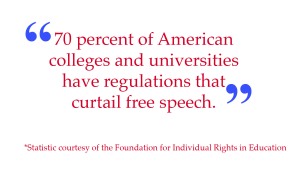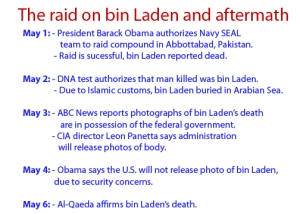Deeply rooted in the extent of ideas, a liberal arts education is one that allows its students to learn general information about a variety of topics and studies.
Areas of learning through the liberal arts — such as literature, language, philosophy, history, mathematics and science — are intended to provide rich dialogue among students, while fostering intellectual growth, stimulating higher thinking and allowing students to freely and openly discuss their ideas and thoughts.
Public vs. Private in First Amendment cases
At public universities across the nation, this type of dialogue is protected by the First Amendment, allowing individual certain freedoms from governmental interference. Since public universities are owned by the state, school administrators are limited in curtailing free speech, allowing collegiate media outlets to be as open and honest as possible.
But private universities do not have this same freedom. As a public entity, the First Amendment does not protect individual freedoms against private organizations.
“The First Amendment does not strictly apply to a private setting,” said Paul Parsons, dean of the School of Communications at Elon University. “Private universities have the opportunity to intervene in the content of its school’s media, although most typically take a hands-off approach, allowing its students the freedom of expression and thoughtfulness.”

Graphical display by Jack Rodenfels
A recent study by the Foundation for Individual Rights in Education (FIRE) found that 70 percent of American colleges and universities have regulations that curtail free speech.
Simply because regulations are in place doesn’t mean that free speech on college campuses is limited. Largely, it means that there are regulations in place to restrain hate speech – speech that is defames a person based on characteristics such as race, gender, ethnicity, religion, and others.
“As a student, my most important right is to freely share my thoughts and ideas with others,” Elon University sophomore Alexa Behar said. “Through sharing with others inside and outside of the classroom, I’m able to collaborate with them and learn more about the world around me.”
Laboratory vs. Public Forum
More than just speech through classrooms, freedom of speech transcends into other aspects of university life, such as student media. In a private university setting, Parsons said there is a difference between student media as a “laboratory” and a “public forum”. A laboratory media outlet is one where students work to get a grade and a professor is residing over the class, deciding what gets put into the public eye and how that message is conveyed.
One such example of a laboratory newspaper belongs to Cuyahoga Community College in Cleveland, Ohio. Students work in classroom settings under direct tutelage of professors to produce content for the school newspaper.
“By taking a class called staff practices, we get the opportunity to work on a college newspaper,” freshman Thomas McGeoch said, a student at Cuyahoga Community College. “An adviser looks over our material before we put it in the newspaper and gives input on our article choice and placement.”
A “public forum” media outlet, on the other hand, is one where students have more freedom to express their views. By having an independent media outlet, editors and staff determine the content of the newspaper, television, radio show, or other medium. There is no prior review of the content.
“Public forums for expression are given a lot more latitude and freedom than laboratory papers in terms of its overall content,” Parsons said.
Public forum media outlets give universities additional opportunities for students to exercise free speech, as students are responsible for the entire production process.
Speech Codes in concordance with First Amendment Rights
Across the country, many universities have enacted “speech codes”—regulations that limit and even ban speech, when deemed necessary, beyond the legal limitations of freedom of speech in the United States Constitution, according to the Foundation for Individual Rights in Education.

Graphical display by Jack Rodenfels
While applied and enforced to limit hate speech, it’s important to make sure that speech codes do not bleed into honest and open dialogue, while limiting constructive thoughts and ideas on college campuses, according to Monica Hill, director of the North Carolina Scholastic Media Association.
“Speech codes should only be used when absolutely necessary – in instances of hate speech,” Hill said. “Otherwise, it means discrediting someone’s ideas, and writing it off to be censored.”
This is the cause for concern among colleges and universities in the United States — the rules and regulations that differentiate between public universities and private universities, and how First Amendment rights are uniquely apparent to both types of universities.
“Since schools like ours are funded by the state, free speech at public universities isn’t as pressing as an issue in public universities as it is in private universities,” said John Colwell, a former administrator at The Ohio State University in Columbus, Ohio. “Public universities allow for more open and honest discussion, even criticism from students, without the fear of reproach from administrators at that university to censor the speech.”
While private universities can censor speech, it is important to not practice censoring speech unless it is seen as imminently dangerous to its students, Frank Lebo, a professor at Baldwin-Wallace College said.

Graphical display by Jack Rodenfels
“Although we are a private university, we certainly allow for our students to engage in civic dialogue that adds to the common good,” Lebo said, teaching at a private liberal arts college located in Berea, Ohio. “We want students to actively and openly discuss their ideas and know that they are important and certainly valuable to our society.”
Free Speech Zones
Part of the dialogue surrounding the aforementioned speech codes center around designated free speech zones found at colleges and universities across the nation. Starting in the 1980s in the United States, free speech zones are places where students “can speak their minds, hold rallies and demonstrations, distribute literature and engage in unrestricted, robust, open discourse,” according to Student Press Law Center.
“Free speech zones are afterthoughts on many college campuses,” Hill said. “Confined within a small area, they are usually out of the way and aren’t heavily pursued. While limiting where free speech can occur, learning inside of the classroom becomes limited.”
Free speech zones don’t always effectively allow free speech, Hill said, noting prior cases at universities where administration limited free speech via the school’s free speech zones.
One such case included Brigham Young University where then-Vice President Dick Cheney was invited to speak at a commencement ceremony in 2007. With the right to protest the speech, BYU administration shut down free speech areas early, declaring that the free speech zones were interrupting campus life, when 700-900 BYU students and faculty were able to participate in free speech during the Cheney speech.
Future of Free Speech on College Campuses
With the ability to restrain and limit freedom of speech when seen as appropriate, private universities will continue to have the final say as to what speech, if any, is censored at their respective university.
While continuing to pursue different ways of allowing free speech among its students, taking teachable moments can prepare students for life after college, where they can be affluent, well-informed citizens looking to make a difference in their communities, Parsons said.
“There is a teaching element to student media and student’s dialogue,” Parsons said. “Students can learn through some guidance of an adviser, and the training aspect makes students ready for the real world.”
Universities – both public and private – offer First Amendment courses, where students can learn more about freedom of speech and expression, and how it values society, as well as the potential harms it allows in societies. Through these classes, universities are training young minds to better understand the First Amendment, and how it applies to their future.
“As we get older and become the dominant generation, freedom of speech issues will be increasingly found on the internet,” senior Dan Shulman said. “By learning about these issues, we can be more informed citizens and better understand what freedom of speech looks like.”












